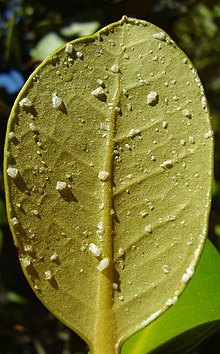Salt gland

In biology , the salt glands are all glands that excrete excess salt . Corresponding glandular cells can be found in salt-tolerant plants and as compact glands in a number of different sea-bound animal groups for osmoregulation .
Salt glands in botany
In botany, the salt glands are specialized gland cells of the epidermis with which plants are able to excrete excess salt. These cells are mainly found in plants in extremely salty locations, i.e. in the so-called halophytes . The excretion of the salts takes place actively in these cells, i.e. with the application of energy , by ion transport through the cell membrane , and is accordingly only used in the case of excess salt (see elimination in salt plants ).
In addition to plants from the mangroves , pioneer plants in the beach area such as the common sea lavender ( Limonium vulgare ), the beach milkweed ( Glaux maritima ), the beach trident ( Triglochin maritimum ) and the silt grass ( Spartina anglica ) have salt glands.
Salt glands in zoology
Fish, amphibians and reptiles
Salt glands can at various vertebrates be formed to the osmoregulation to support and excrete excess salt. They are found accordingly in a number of marine animals as well as in animals that live in the brackish water of the estuaries . This is, for example, the orbital glands at sea turtles , the sublingual gland in sea snakes and salt glands on the surface of the tongue in marine crocodiles , also exist in a variety of cartilaginous fish salt glands in the rectum open the animals. Other forms can be found in various bony fish, other reptiles and a few amphibians.
Sea birds
The most well-known glands of this type, usually referred to as salt glands, are found in marine birds in the form of paired nasal glands above the eyes, through which a highly salty secretion is released into the nostrils and excreted in this way. These glands have a complex structure and consist of several thousand tubules , each with a transport epithelium and located in a capillary network . The concentration of the salt in the secretion takes place using the countercurrent principle . The energy required for active transport is provided by a Na + / K + -ATPase. This allows the excretory secretion to double the salt concentration of seawater. Particularly high concentrations occur in deep sea birds such as the albatrosses , which ingest high salt concentrations through their food.
Salt glands can be detected in a number of groups of birds of different orders and are homologous and developed. They allow conclusions to be drawn about a closer relationship between the corresponding groups of birds, as the complex organ can be assumed to have developed once. The bird orders in which salt glands have been detected include tube-noses , barefoots , waders , flamingos , geese , birds of prey and plover-like (which contain the seagulls ).
literature
- Salt glands. In: Herder-Lexikon der Biologie. Spektrum Akademischer Verlag, Heidelberg 2003, ISBN 3-8274-0354-5 .
Individual evidence
- ↑ JP Hildebrandt: Changes in Na + / K + -ATPase expression during adaptive cell differentiation in avian nasal salt gland. In: Journal of experimental biology. Volume 200 Edition: 13 July 1997, pp. 1895-1904.